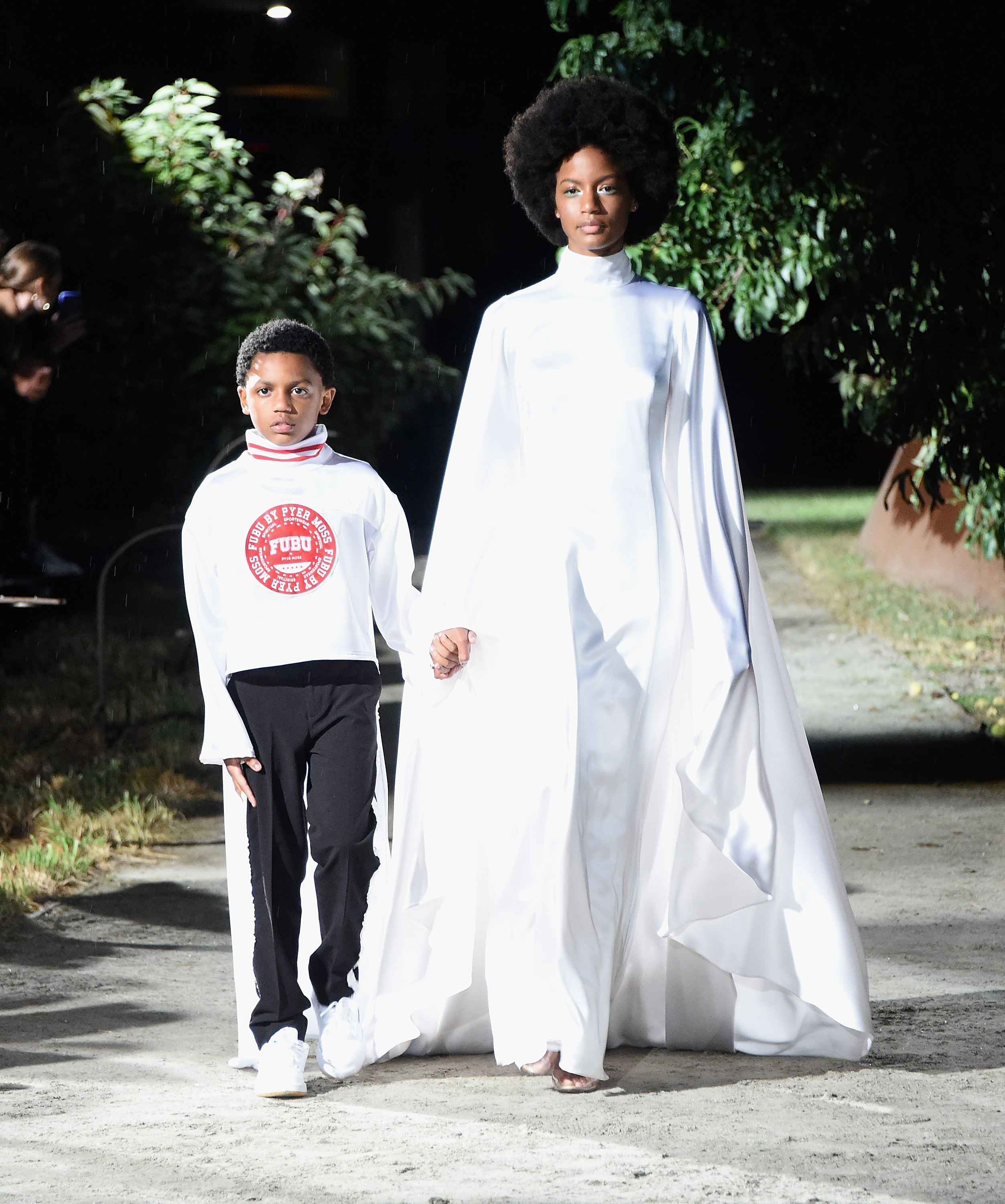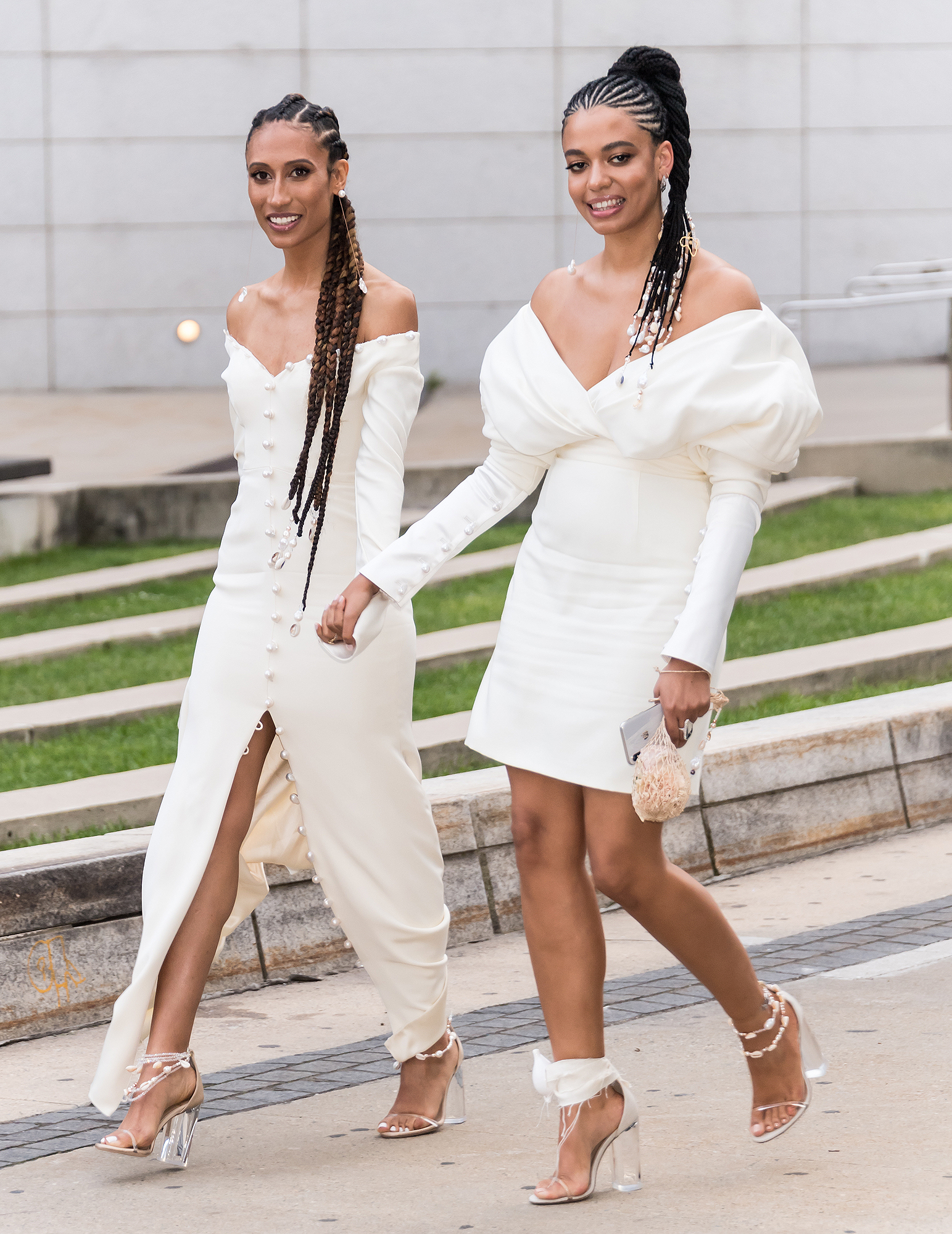Designer Virgil Abloh. Photo credit: Francois Guillot/AFP/Getty Images
A gospel choir sang as the first model to walk the runway for Pyer Moss’ Spring/Summer 2019 collection emerged in an ethereal white silk gown styled with teal eyeliner and an afro. She walked hand-in-hand with a young black boy wearing a FUBU by Pyer Moss sweater as the rain fell. The collection, designed by the 2018 winner of the prestigious CFDA/Vogue Fashion Fund Kerby Jean-Raymond, debuted at the Weeksville Heritage Center in Brownsville, Brooklyn.
By the end of his latest preview, 48 black models had displayed Jean-Raymond’s work, including a dress featuring a black father soothing his baby, a green silk set with multi-hued-black faces, and a white cummerbund with “See us now?” embroidered across it. Jean-Raymond is no stranger to weaving social commentary about the black American experience into his work—the designer screened a short documentary he’d produced about police brutality at his spring/summer 2016 show. To too many, black bodies are a threat, and black culture is expendable.
In Jean-Raymond’s case, his show was rightfully celebrated as a step towards diversity of perspectives in fashion, but inclusion in the fashion industry is hardly discernible. The runways of the latest New York Fashion Week featured 44.8 percent models of color, more than any other year according to The Fashion Spot. But while the runways have diversified exponentially, the number of black designers has not. “People still like to sit across the desk from people who look like them,” said Mark-Evan Blackman, professor at the Fashion Institute of Technology.

Models walks the runway at Pyer Moss' Summer/Spring runway show. Photo by Dimitrios Kambouris/Getty Images.
A small number of the more than 500 members of the Council of Fashion Designers of America are black. The Cut reported that, “Less than 10 percent of the 146 fashion designers who showed at the major fall 2018 shows for New York Fashion Week were black.” The fashion industry has been slow-moving to embrace designers of color, but a handful of young black designers are using their platforms to incorporate their identities and experiences into their offerings.
When designer Recho Omondi held her first show in Chelsea, a cast of all-black models carried her designs down the runway. “For me, it felt like the natural thing to do,” said Omondi, whose identity informs her eponymous womenswear brand. “When I did that show four years ago, no one had done that.”
Born to Kenyan parents in Oklahoma, Omondi, who received her B.F.A from the Savannah College of Art and Design, isn’t shy to the fact that she’s among a handful of black female designers in the industry. The Brooklyn-based designer releases one thoughtful collection a year. So far, each has been shot by a black photographer and presented on black models. The latest collection, photographed by Micaiah Carter in an abandoned locker room overrun by shrubbery, features hyperbolic proportions, romantic silhouettes, tulle, and mostly muted colors.
“When I refer to my identity or my culture, it's not so unique what I'm doing, it’s just a different perspective,” she said. Omondi, who counts Solange Knowles and Issa Rae as admirers, has demonstrated that there’s always been a place for black women in an industry that has historically been interested in exploring their identity, but not in its entirety.
Today almost everything on the designer’s site, from her best-selling sweater with “N*****” hand-embroidered in the corner, to her cashmere trousers, is sold out. “In the past, fashion narratives have been very bourgeois because it was very aspirational and exclusive,” said Omondi. “Now we’ve entered this time where more people can participate.”
Even so, no black designer has comparable name recognition, financial investment, or fervor to the Donna Karens, Diane Von Furstenbergs, or Alexander McQueens. Carly Cushnie and Tracy Reese, both black designers, have created modern feminine clothes for more than a decade. Olivier Rousteing is the creative director of Balmain. It’s Virgil Abloh of Off-White, who recently debuted his first collection as the artistic director of Louis Vuitton menswear, who’s come closest.
“We historically haven’t had access to that access and resources,” said Julee Wilson, fashion and beauty director at Essence. “It’s important for me to do my part as far as getting the word out there about designers of color that are awesome, but I can’t get them into a factory necessarily, or floor space at Bergdorf's.”

Issa Rae wearing Recho Omondi's N**** sweater on 'Insecure.' Photo courtesy of HBO.
Part of the problem is that the fashion industry is veiled in mystery. For new designers, there’s no clear path to starting and maintaining a brand. Success in fashion is often synonymous with access and money, or access to money, so designing is closed off to those that don’t have the capital.
In the eighties, Mississippi-born designer Patrick Kelly, moved to New York City to pursue a career in fashion. Snubbed by the city’s fashion hierarchy, the designer’s friend Renaldo Barnette said Kelly relocated to Paris, where he debuted his electric ready-to-wear women’s collection in 1985. Like Kelly’s dresses and jackets, his models were bold and colorful. He was the first American designer to be inducted to the Chambre Syndicale, a prestigious design community in France. Before Kelly died in 1990, his designs were well-known in the U.S and France and had been featured in French Elle. According to Barnette, he’d received financial backing from Warnaco, an American clothing conglomerate.
“I think people who had access to fashion most of their lives were people who were affluent most of their lives,” said Aurora James, founder of the artisanal accessories brand, Brother Vellies. It’s a systematic problem in America that most of those people happen to be white, added James, who is optimistic that the industry is becoming more open-minded to people of color. The Toronto-native, whose father is Ghanaian, is interested in preserving the artistry behind each Brother Vellies piece and does so by paying a living wage to the communities she employs in South Africa, Kenya, Morocco, Ethiopia, Burkina Faso, Haiti, Mali, Haiti, Italy, and Bali.
Kim Jenkins teaches about the intersection of race and fashion at Parsons School of Design in New York and finds that for designers of color, “Their education and the breadth of their knowledge is underestimated. You have to work three or four times as hard as your white counterparts.”

Aurora James (R) with Elaine Welteroth, editor in chief of Teen Vogue. Photo by Gilbert Carrasquillo/GC Images.
The best-known opportunity for emerging designers to secure funding is through the Council of Fashion Designers of America/Vogue Fashion Fund. Annually, the Fund provides $400,000 to one first place winner and $150,000 each to the two runners-up. Past winners have included fashion powerhouses Proenza Schouler, Alexander Wang, and Altuzarra. Brother Vellies won the prize in 2015 and Telfar Clemens of Telfar won first place last year.
Telfar, a socially-conscious designer, collaborated with White Castle on a capsule collection and 100 percent of the proceeds were donated to the Robert F. Kennedy Fund for Freedom and Human Rights to help minors pay bail on Rikers Island. Indifferent to the scarcity and exclusivity that drives much of the hype in fashion, Telfar’s site reads, “It's not for you — it's for everyone.” Telfar is Liberian-American and his designs are gender-fluid. His latest collection was reminiscent of the 1970s, featuring bell bottoms, mixed denim, and exaggerated cut-outs.
While the fashion industry prides itself on its open-mindedness, it’s long been helmed by white designers and editors, and finds itself wrestling with how to respond to a political climate that castigates women, minorities, and immigrants. As social media has partially democratized access, these gatekeepers must make decisions in front of an audience. Designers including Clemens, Omondi, James, and Jean-Raymond have established that representation in fashion isn’t a trend, but rather a best practice.
“For the first time, Americans are starting to understand that American does not just mean cherry pie and cowboy boots,” said Omondi. “People want to be able to tell their own stories rather than having their stories told for them.”
Sign up for our newsletter to get the best of VICE delivered to your inbox daily.
Follow Patricia Yacob on Twitter.
No comments:
Post a Comment